The Great Padlock Mystery
by Bob Brooke
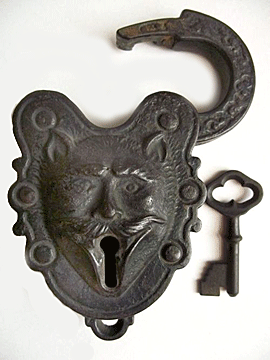 QUESTION: QUESTION:
I’ve found a Victorian padlock that I’d like to
buy. Does it go back to the mid- 1800's during Queen Victoria's
reign? It’s quite large, measuring 6 inches high x 4 inches wide
x 1.5 inches deep. Was that a common size? The seller told me
it’s called an "Iron Smoke House Lock," What does that mean?
Thanks,
Alex
____________________________________________________
ANSWER:
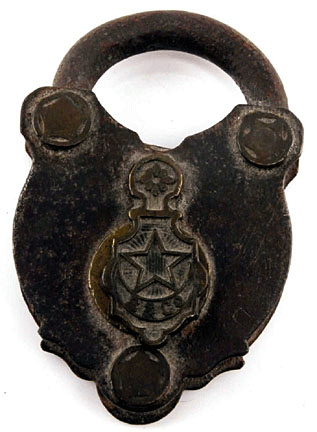 The
lock you’re thinking of purchasing isn’t all that rare. During the
Industrial Revolution in England, Midland lock makers produced them by
the thousands. The
lock you’re thinking of purchasing isn’t all that rare. During the
Industrial Revolution in England, Midland lock makers produced them by
the thousands.
As England moved slowly from an agrarian culture to an industrial one
towards the end of the 18th century, locksmiths began designing locks
that cost less and had more strength. But burglars kept one step ahead
of them. Up to that time, only wealthy merchants could afford strong
locks.
The average person had to make do with poorly made penny padlocks to
protect his coal storage bin from thieves, and homeowners wanted locks
for their doors and windows. With an increase in thievery, people
demanded locks for everything from Bibles to carriages to schools and
warehouses.
The answer to everyone’s needs was the padlock, a portable, if not
somewhat cumbersome, device to protect against forced entry.
Robert Barron invented the double–acting tumbler lock in 1778. The
tumbler or lever falls into a slot in the bolt which will yield only if
the tumbler is lifted out of the slot to exactly the right height.
Barron’s lock had two such levers, each of which had to be lifted to a
different height before the bolt could be withdrawn.
Jeremiah Chubb improved on Barron's lock n 1818 . He incorporated a
spring into the lock which would catch and hold any lever that had been
raised too high by a lock picker. Not only did design add an extra level
of security, it showed when someone had tampered with the lock.
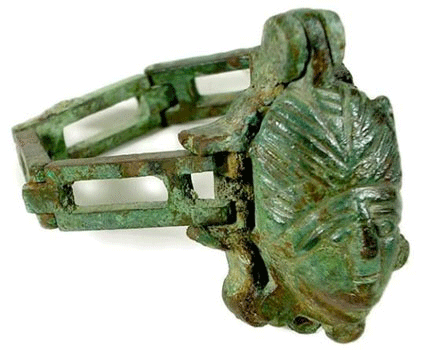 Early
padlocks offered convenience since people could carry them and use them
where necessary. Historians believe the Romans were the first to use
padlocks. Roman padlocks had a long bent rod attached to the case and a
shorter piece which could be inserted into the case. There’s also
evidence that merchants traveling the ancient trade routes to Asia and
China used them to protect their goods. Early
padlocks offered convenience since people could carry them and use them
where necessary. Historians believe the Romans were the first to use
padlocks. Roman padlocks had a long bent rod attached to the case and a
shorter piece which could be inserted into the case. There’s also
evidence that merchants traveling the ancient trade routes to Asia and
China used them to protect their goods.
Padlocks have been used in China since the late Eastern Han Dynasty,
dating from 25–220 AD. Early Chinese padlocks were mainly "key-operated
locks with splitting springs and partially keyless letter combination
locks. Chinese craftsmen made them from bronze, brass, silver, and other
materials.
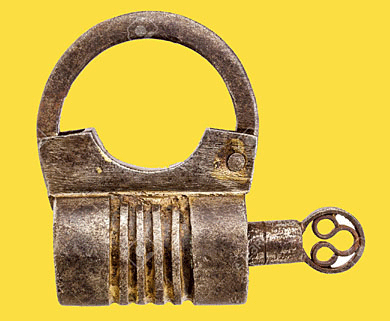 Padlocks
became known as “smokehouse locks” because people commonly used them to
lock their meat in their smokehouses to prevent poachers from stealing
it. Designed in England and formed from wrought iron sheet and employed
simple lever and ward mechanisms, these locks afforded little protection
against forced entry. Contemporary with the smokehouse padlocks and
originating in the Slavic areas of Europe were "screw key" padlocks.
These opened with a helical key threaded into the keyhole. The key
pulled the locking bolt open against a strong spring. Improved
manufacturing methods allowed the manufacture of better padlocks that
put an end to the Smokehouse around 1910. Padlocks
became known as “smokehouse locks” because people commonly used them to
lock their meat in their smokehouses to prevent poachers from stealing
it. Designed in England and formed from wrought iron sheet and employed
simple lever and ward mechanisms, these locks afforded little protection
against forced entry. Contemporary with the smokehouse padlocks and
originating in the Slavic areas of Europe were "screw key" padlocks.
These opened with a helical key threaded into the keyhole. The key
pulled the locking bolt open against a strong spring. Improved
manufacturing methods allowed the manufacture of better padlocks that
put an end to the Smokehouse around 1910.
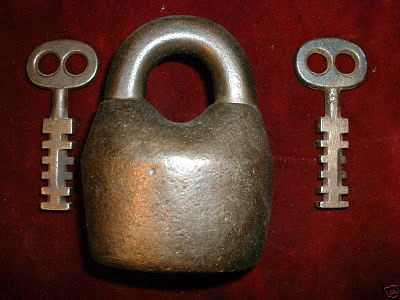 Around
the 1850s, "Scandinavian" style locks, or "Polhem locks", invented by
the Swedish inventor Christopher Polhem, became a more secure
alternative to the prevailing smokehouse and screw locks. These locks
had a cast iron body that was loaded with a stack of rotating disks.
Each disk had a central cutout to allow the key to pass through them and
two notches cut out on the edge of the disc. When locked, the discs
passed through cut-outs on the shackle. The key rotated each disk until
the notches, placed along the edge of each tumbler in different places,
lined up with the shackle, allowing the shackle to slide out of the
body. The McWilliams company received a patent for these locks in 1871.
The "Scandinavian" design was so successful that JHW Climax & Co. of
Newark, New Jersey continued to make these padlocks until the 1950s. Around
the 1850s, "Scandinavian" style locks, or "Polhem locks", invented by
the Swedish inventor Christopher Polhem, became a more secure
alternative to the prevailing smokehouse and screw locks. These locks
had a cast iron body that was loaded with a stack of rotating disks.
Each disk had a central cutout to allow the key to pass through them and
two notches cut out on the edge of the disc. When locked, the discs
passed through cut-outs on the shackle. The key rotated each disk until
the notches, placed along the edge of each tumbler in different places,
lined up with the shackle, allowing the shackle to slide out of the
body. The McWilliams company received a patent for these locks in 1871.
The "Scandinavian" design was so successful that JHW Climax & Co. of
Newark, New Jersey continued to make these padlocks until the 1950s.
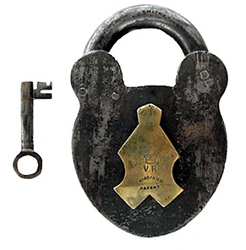 Contemporary
with the Scandinavian padlock, were the "cast heart" locks, so called
because of their shape. A significantly stronger lock than the
smokehouse and much more resistant to corrosion than the Scandinavian,
these locks had a lock body sand cast from brass or bronze and a more
secure lever mechanism. Heart locks had two prominent characteristics:
one was a spring-loaded cover that pivoted over the keyhole to keep dirt
and insects out of the lock that was called a "drop". The other was a
point formed at the bottom of the lock so a chain could be attached to
the lock body to prevent the lock from getting lost or stolen. Cast
heart locks were very popular with railroads for locking switches and
cars because of their economical cost and excellent ability to open
reliably in dirty, moist, and frozen environments. Contemporary
with the Scandinavian padlock, were the "cast heart" locks, so called
because of their shape. A significantly stronger lock than the
smokehouse and much more resistant to corrosion than the Scandinavian,
these locks had a lock body sand cast from brass or bronze and a more
secure lever mechanism. Heart locks had two prominent characteristics:
one was a spring-loaded cover that pivoted over the keyhole to keep dirt
and insects out of the lock that was called a "drop". The other was a
point formed at the bottom of the lock so a chain could be attached to
the lock body to prevent the lock from getting lost or stolen. Cast
heart locks were very popular with railroads for locking switches and
cars because of their economical cost and excellent ability to open
reliably in dirty, moist, and frozen environments.
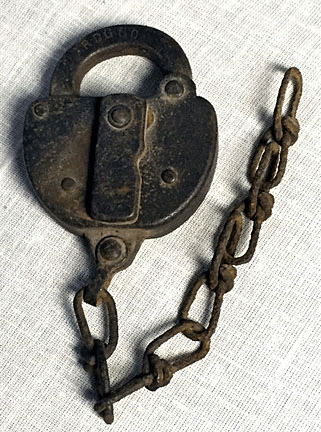 Around
the 1870s, lock makers realized they could successfully package the same
locking mechanism found in cast heart locks into a more economical steel
or brass shell instead of having to cast a thick metal body. These lock
shells were stamped out of flat metal stock, filled with lever tumblers,
and then riveted together. Although more fragile than the cast hearts,
these locks were attractive because they cost less. In 1908, Adams &
Westlake patented a stamped & riveted switch lock that was so economical
that many railroads stopped using the popular cast hearts and went with
this new stamped shell lock body design. Many lock manufacturers made
this very popular style of lock. Around
the 1870s, lock makers realized they could successfully package the same
locking mechanism found in cast heart locks into a more economical steel
or brass shell instead of having to cast a thick metal body. These lock
shells were stamped out of flat metal stock, filled with lever tumblers,
and then riveted together. Although more fragile than the cast hearts,
these locks were attractive because they cost less. In 1908, Adams &
Westlake patented a stamped & riveted switch lock that was so economical
that many railroads stopped using the popular cast hearts and went with
this new stamped shell lock body design. Many lock manufacturers made
this very popular style of lock.
Each lock consisted of a body, shackle, and a locking mechanism. The
typical shackle is a “U” shaped loop of metal that encircles whatever is
being secured by the padlock. Most padlock shackles either swung away or
slid out of the padlock body when in the unlocked position. Improved
manufacturing methods allowed the manufacture of better padlocks that
put an end to the Smokehouse around 1910.
<
Back to Readers Ask Archives
Next Article > |
